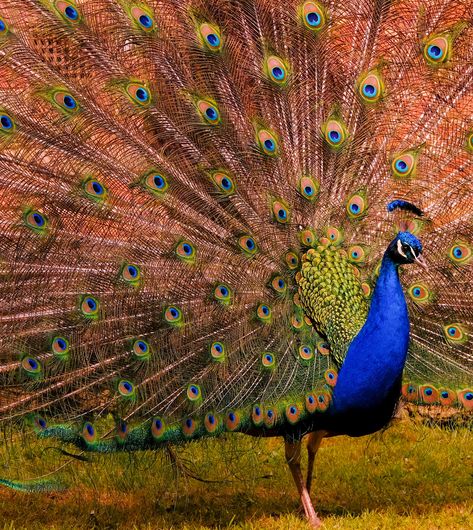The Indian Blue Peafowl (Pavo cristatus), also known simply as the Blue Peafowl, is one of the most iconic and recognizable birds in the world. Renowned for its dazzling display of iridescent plumage, particularly in males, this species is native to the Indian subcontinent and has been celebrated in art, mythology, and culture for centuries. It is the national bird of India and holds significant cultural and symbolic importance. In addition to its natural habitat, the Indian Blue Peafowl is widely kept in ornamental collections and estates around the globe due to its stunning appearance and majestic demeanor.
Physical Characteristics
The Indian Blue Peafowl is a large, ground-dwelling bird with a striking sexual dimorphism between males and females.
Males (Peacocks):
- Males are famous for their train of elongated upper tail covert feathers, which are vividly iridescent and adorned with eye-like patterns in hues of blue, green, and gold.
- The train is not part of the true tail but extends over the bird’s short tail feathers.
- The head, neck, and breast are covered in iridescent metallic blue feathers, while the wings are a mix of green, black, and brown.
- A crown of upright feathers on the head enhances the bird’s regal appearance.
- During courtship, males fan their train into a magnificent display to attract females, often accompanied by a unique courtship dance.
Females (Peahens):
- Females are smaller and lack the elaborate train.
- Their plumage is predominantly brown with hints of green on the neck, offering camouflage while nesting.
- Unlike the males, peahens have muted colors, but they share the elegant crown of feathers on their head.
Both males and females have long, sturdy legs, a sharp beak, and strong wings, although they are primarily ground-dwelling birds.
Habitat and Distribution
Native to the Indian subcontinent, the Indian Blue Peafowl inhabits a variety of environments, including:
- Deciduous forests
- Grasslands
- Scrublands
- Agricultural areas
The species is highly adaptable and can thrive near human settlements. It is often found in parks, gardens, and estates where it has been introduced outside its native range. Wild populations are now spread across several countries, including the USA, Australia, and parts of Europe.
Behavior and Social Structure
Indian Blue Peafowl are highly social birds that typically live in small groups called parties, consisting of a few females and a dominant male. They are primarily diurnal and spend their days foraging for food on the ground.
Communication:
- They are known for their loud, piercing calls, especially during the breeding season.
- These calls often serve as alarm signals to warn of predators, and peafowl are highly alert birds.
Foraging and Diet:
Indian Blue Peafowl are omnivorous, with a diet that includes:
- Grains
- Seeds
- Fruits
- Insects
- Small reptiles and amphibians
Their foraging behavior plays a role in seed dispersal, contributing to ecosystem health.
Reproduction and Courtship
The breeding season usually occurs during the monsoon. Males perform elaborate courtship displays, fanning out their trains and shaking them to produce a shimmering effect while emitting low-frequency sounds to attract females.
- Nesting: Peahens build shallow nests on the ground, often in hidden locations, and lay 4–6 eggs per clutch.
- Incubation: Eggs are incubated for about 28–30 days by the female, who also provides sole care for the chicks after hatching.
- Chicks: Peafowl chicks are precocial, able to walk and forage shortly after hatching, but they stay close to their mother for protection.
Cultural Significance
The Indian Blue Peafowl holds profound cultural and symbolic importance:
- In Indian mythology, the bird is associated with Lord Krishna, who wears a peacock feather in his crown.
- In Hinduism, it is considered a symbol of beauty, prosperity, and protection.
- Peafowl motifs frequently appear in art, architecture, and traditional textiles throughout South Asia.
Conservation Status
The Indian Blue Peafowl is listed as Least Concern by the IUCN due to its wide range and stable population. However, threats such as habitat loss, hunting, and poaching for feathers and meat can affect localized populations. Conservation efforts focus on habitat preservation and cultural awareness to protect this magnificent bird.
Conclusion
The Indian Blue Peafowl (Pavo cristatus) is a spectacular bird admired for its unparalleled beauty, ecological significance, and cultural importance. Its iridescent plumage, unique courtship displays, and adaptability have made it a symbol of elegance and majesty. Whether in the wild or as part of ornamental collections, the Indian Blue Peafowl continues to captivate the hearts and imaginations of people worldwide.








Reviews
There are no reviews yet.